Siam Cement Bundle
Who Really Controls Siam Cement Company?
Unraveling the ownership of a major corporation is key to understanding its strategic direction and future prospects. The Siam Cement SWOT Analysis provides a deeper dive into the company's strengths and weaknesses. This deep dive into Siam Cement Company ownership reveals the forces shaping its decisions and its impact on the Southeast Asian market.
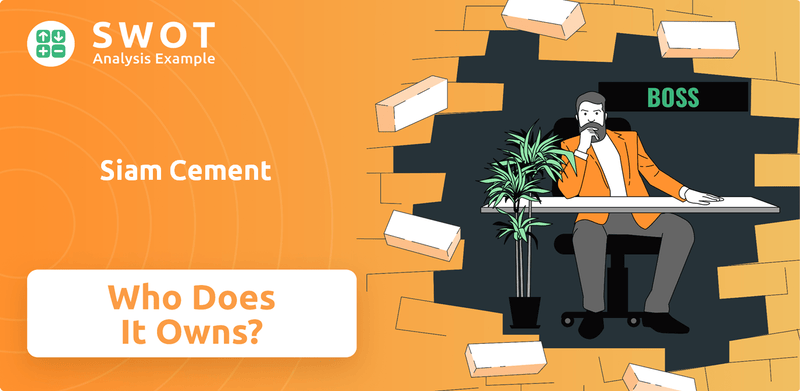
From its royal beginnings to its current status as a multinational conglomerate, understanding who owns Siam Cement Company, or SCG, is vital. This exploration will examine the Siam Cement history, tracing the evolution of its ownership structure. Discovering the SCG owner and the major shareholders provides critical insights into this significant Thai business ownership.
Who Founded Siam Cement?
The Siam Cement Company, the precursor to the Siam Cement Group (SCG), was established in 1913. This was initiated by a royal decree from King Vajiravudh (Rama VI) of Thailand. The company's early ownership reflected a strong governmental and royal interest, typical of the time.
The primary aim of Siam Cement was to produce cement for Thailand's infrastructure. This reduced the need for imported materials. The initial setup was a state-sponsored enterprise, focusing on national development rather than private investment.
The Royal Thai Government provided the initial capital and direction for the company. Specific details about equity splits or shareholdings among private entities at the beginning are not readily available. The focus was on national development and industrialization.
The formation of Siam Cement Company was authorized by a royal decree from King Vajiravudh (Rama VI) in 1913.
The company was essentially a state-sponsored enterprise. This was aimed at promoting industrial self-sufficiency.
The primary objective was to produce cement for the nation's infrastructure. This reduced reliance on imported materials.
Early ownership was heavily influenced by state policies and national development goals. The Royal Thai Government was the main driver.
There were no notable early backers or angel investors. The focus was on national progress and industrialization.
The founding vision was intrinsically tied to national progress and industrialization. Control resided within the state.
Understanding the initial ownership of Siam Cement Company, or who owns Siam Cement, is crucial for grasping its history. The company's origins are deeply rooted in royal and governmental initiatives, setting the stage for its future. For more insights into the company's structure, you can explore the Revenue Streams & Business Model of Siam Cement.
- The Royal Thai Government was the primary 'founder' in spirit.
- The company's initial goal was to boost industrial self-sufficiency.
- Control and strategic direction were heavily influenced by state policies.
- There were no private investors or early backers in the initial phase.
Siam Cement SWOT Analysis
- Complete SWOT Breakdown
- Fully Customizable
- Editable in Excel & Word
- Professional Formatting
- Investor-Ready Format
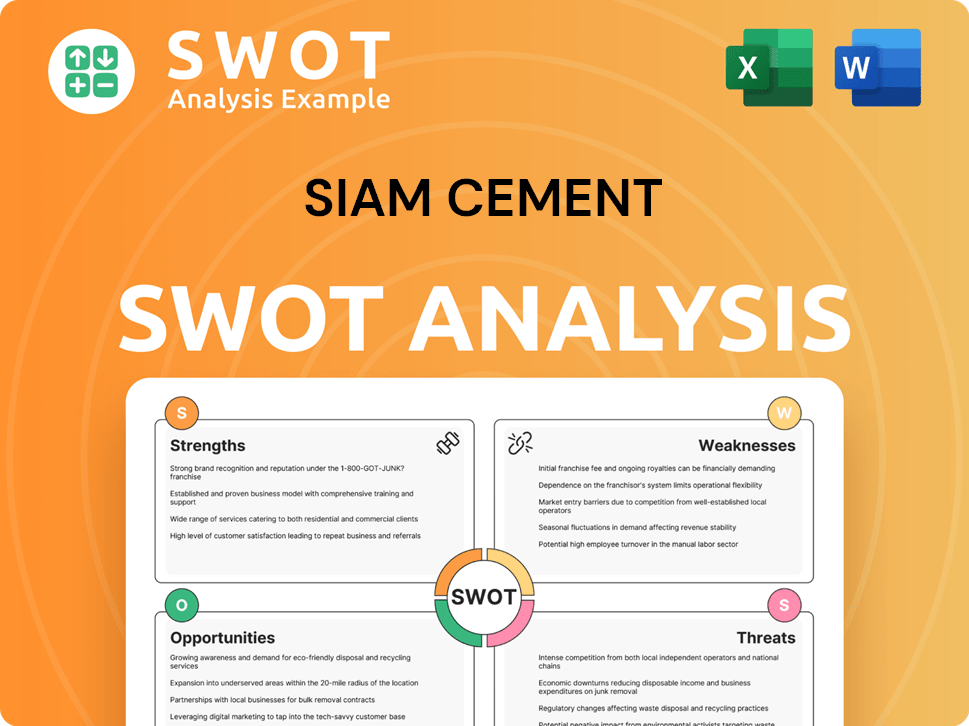
How Has Siam Cement’s Ownership Changed Over Time?
The evolution of Siam Cement Group (SCG)'s ownership reflects a significant transformation since its inception. Initially, the company operated under state control. A key milestone in SCG's history was its listing on the Stock Exchange of Thailand (SET). This transition marked a shift from a state-controlled entity to a publicly listed company, opening up opportunities for broader ownership and investment.
The initial public offering (IPO) date and the exact initial market capitalization require specific historical financial records. However, SCG has been a prominent fixture on the SET for decades, allowing public shareholding and reflecting its growth and adaptation within the Thai business landscape. This change facilitated the involvement of diverse stakeholders, including institutional and individual investors, shaping the company's governance and strategic direction.
| Key Event | Impact on Ownership | Details |
|---|---|---|
| Founding of SCG | Initial State Control | SCG began as a state-controlled entity, reflecting government influence in key industries. |
| Listing on the SET | Public Offering and Diversification | The IPO allowed for public shareholding, expanding the ownership base and introducing market dynamics. |
| Increased Institutional Investment | Influence on Strategy and Returns | Greater institutional involvement can shift the focus towards profitability and shareholder value. |
Currently, the Crown Property Bureau (CPB) is the major stakeholder in SCG. As of December 31, 2023, the CPB held 33.5% of SCG's shares, demonstrating its significant influence over the company. Other major shareholders include various institutional investors, both domestic and international, mutual funds, and individual investors. The presence of the CPB alongside public shareholders creates a unique blend of public and private influence, impacting company strategy and governance. This balance ensures stability and long-term vision while responding to market forces. For instance, SCG's reported revenue from sales in 2023 was 499,637 million Thai Baht, with a profit of 25,915 million Thai Baht.
The ownership structure of Siam Cement Company has evolved significantly. The Crown Property Bureau (CPB) remains the largest shareholder. This structure impacts strategy and governance, balancing public and private influences.
- The CPB holds a substantial percentage of shares.
- Institutional investors also hold significant shares.
- SCG is a publicly traded company.
- Learn more about Competitors Landscape of Siam Cement.
Siam Cement PESTLE Analysis
- Covers All 6 PESTLE Categories
- No Research Needed – Save Hours of Work
- Built by Experts, Trusted by Consultants
- Instant Download, Ready to Use
- 100% Editable, Fully Customizable
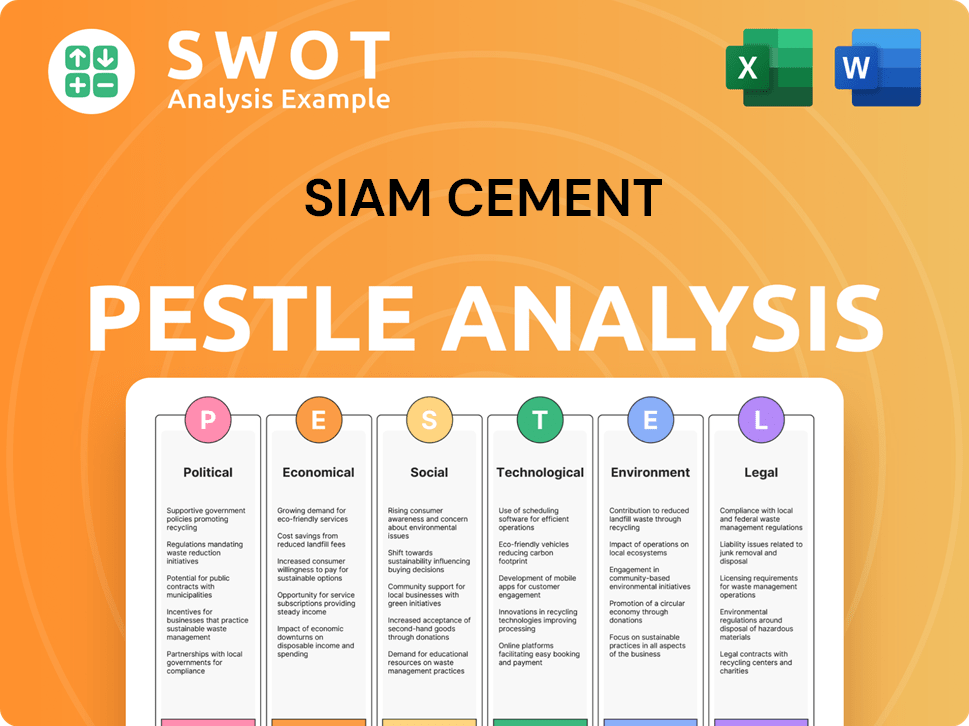
Who Sits on Siam Cement’s Board?
The Board of Directors of Siam Cement Group (SCG) is pivotal in governing the company, balancing interests across its ownership structure, including the significant stake held by the Crown Property Bureau. The board typically consists of representatives from major shareholders, independent directors, and executive directors. While the specific composition changes, individuals with ties to the Crown Property Bureau are often present, reflecting its substantial ownership. Independent directors are appointed to ensure good governance and provide objective oversight, aligning with best practices for publicly listed companies. For the most up-to-date information, one should consult the latest annual reports or official company announcements.
SCG operates under a one-share-one-vote structure, meaning each ordinary share generally carries one vote. This arrangement implies that the Crown Property Bureau, due to its substantial shareholding, holds significant voting power and considerable influence over key corporate decisions. There's no public information suggesting dual-class shares or founder shares granting disproportionate voting rights. The board's composition and voting structure are critical in shaping SCG's strategic direction. For more information about the target market of this company, you can read the article about the Target Market of Siam Cement.
| Board Member | Title | Affiliation |
|---|---|---|
| Mr. Roongrote Rangsiyopash | President and CEO | SCG |
| Mr. Cholanat Yanaranop | Independent Director | Independent |
| Mr. Kan Trakulhoon | Chairman | SCG |
The company's governance framework aims to ensure transparency and accountability to all shareholders. The Crown Property Bureau's enduring presence ensures continuity and alignment with long-term objectives. As of the latest available data, there have been no significant proxy battles or activist investor campaigns challenging the existing board structure or voting power dynamics. SCG's commitment to good governance is reflected in its board composition and voting structure.
The Board of Directors at SCG includes members from significant shareholders, independent directors, and executive directors. The Crown Property Bureau's substantial ownership grants it considerable voting power. SCG uses a one-share-one-vote system.
- The board's composition is crucial for SCG's strategic direction.
- Independent directors ensure objective oversight.
- The Crown Property Bureau's influence is significant.
- SCG maintains a stable governance record.
Siam Cement Business Model Canvas
- Complete 9-Block Business Model Canvas
- Effortlessly Communicate Your Business Strategy
- Investor-Ready BMC Format
- 100% Editable and Customizable
- Clear and Structured Layout
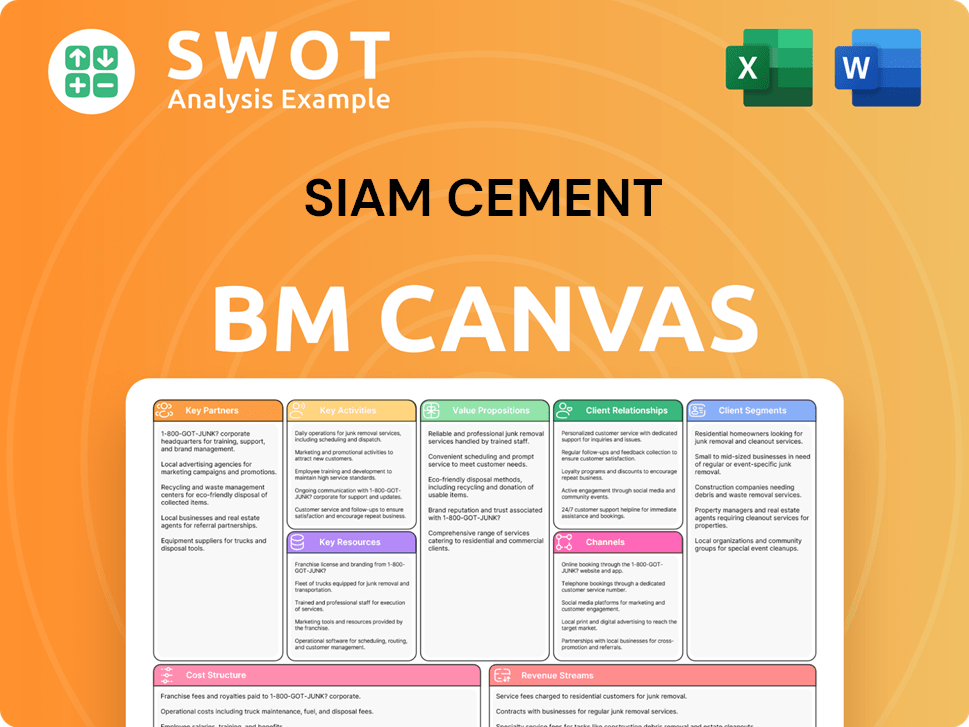
What Recent Changes Have Shaped Siam Cement’s Ownership Landscape?
Over the past few years, Siam Cement Group (SCG) has shown consistent efforts towards sustainable growth and investments in high-value-added products. This approach has attracted institutional investors interested in Environmental, Social, and Governance (ESG) factors. The company's focus on innovation and expansion into ASEAN markets, as highlighted in its 2023 annual report and 2024 outlook, further supports this trend. Strategic investments and partnerships, especially in its Chemicals (SCGC) and Packaging (SCGP) businesses, continue to shape its ownership profile.
SCG's ownership structure remains largely stable, with the Crown Property Bureau holding a significant stake. While there haven't been major share buybacks or secondary offerings that drastically alter the ownership profile, SCG continuously evaluates its capital structure. The company's financial performance, with a reported revenue from sales of 499,637 million Thai Baht in 2023, reinforces its attractiveness to investors. This stability is further supported by the absence of public statements indicating immediate privatization plans or significant shifts in the Crown Property Bureau's stake.
| Aspect | Details | Recent Developments |
|---|---|---|
| Ownership Stability | Crown Property Bureau | Continued significant stake, no major shifts reported. |
| Strategic Investments | SCGC and SCGP | Expansion through acquisitions, capacity enhancements, and partnerships. |
| Financial Performance | Revenue | 499,637 million Thai Baht in 2023 |
The company's strategic direction, emphasizing innovation and green solutions, aligns with the investment criteria of many large institutional funds, potentially influencing its investor base. For more insights into SCG’s strategic direction, consider reading about the Growth Strategy of Siam Cement. SCG’s commitment to sustainability and its financial performance continue to be key factors in its attractiveness to investors within its established ownership framework.
SCG's ownership is largely stable, with the Crown Property Bureau holding a significant stake.
SCG reported a revenue of 499,637 million Thai Baht in 2023, showing robust financial health.
The company emphasizes innovation, green solutions, and expansion into ASEAN markets.
Increased institutional ownership driven by ESG factors is a notable trend.
Siam Cement Porter's Five Forces Analysis
- Covers All 5 Competitive Forces in Detail
- Structured for Consultants, Students, and Founders
- 100% Editable in Microsoft Word & Excel
- Instant Digital Download – Use Immediately
- Compatible with Mac & PC – Fully Unlocked
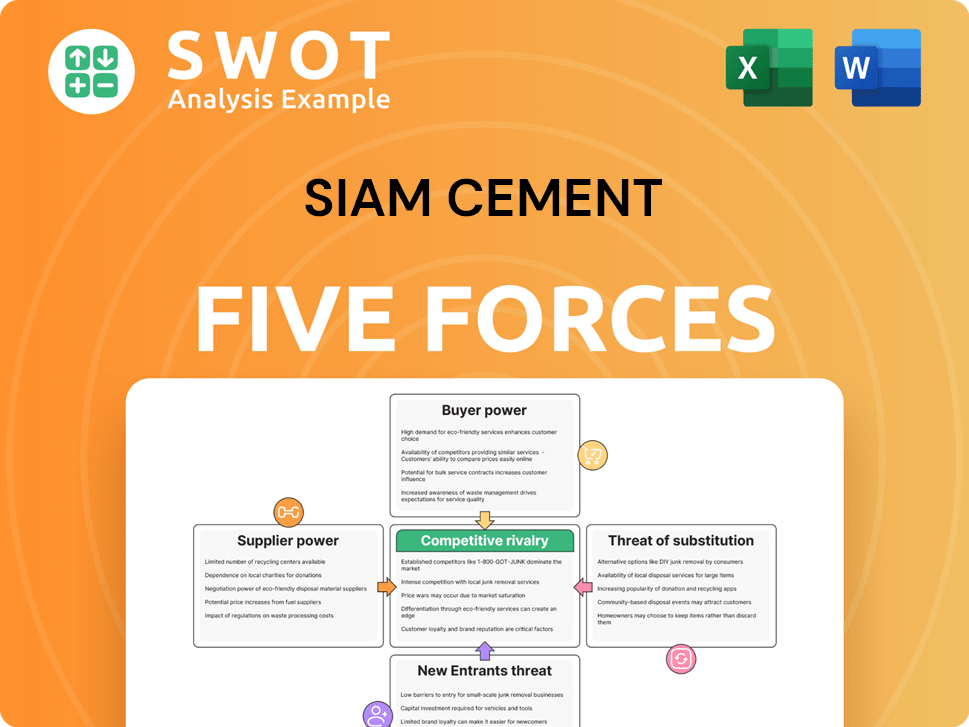
Related Blogs
- What are Mission Vision & Core Values of Siam Cement Company?
- What is Competitive Landscape of Siam Cement Company?
- What is Growth Strategy and Future Prospects of Siam Cement Company?
- How Does Siam Cement Company Work?
- What is Sales and Marketing Strategy of Siam Cement Company?
- What is Brief History of Siam Cement Company?
- What is Customer Demographics and Target Market of Siam Cement Company?
Disclaimer
All information, articles, and product details provided on this website are for general informational and educational purposes only. We do not claim any ownership over, nor do we intend to infringe upon, any trademarks, copyrights, logos, brand names, or other intellectual property mentioned or depicted on this site. Such intellectual property remains the property of its respective owners, and any references here are made solely for identification or informational purposes, without implying any affiliation, endorsement, or partnership.
We make no representations or warranties, express or implied, regarding the accuracy, completeness, or suitability of any content or products presented. Nothing on this website should be construed as legal, tax, investment, financial, medical, or other professional advice. In addition, no part of this site—including articles or product references—constitutes a solicitation, recommendation, endorsement, advertisement, or offer to buy or sell any securities, franchises, or other financial instruments, particularly in jurisdictions where such activity would be unlawful.
All content is of a general nature and may not address the specific circumstances of any individual or entity. It is not a substitute for professional advice or services. Any actions you take based on the information provided here are strictly at your own risk. You accept full responsibility for any decisions or outcomes arising from your use of this website and agree to release us from any liability in connection with your use of, or reliance upon, the content or products found herein.